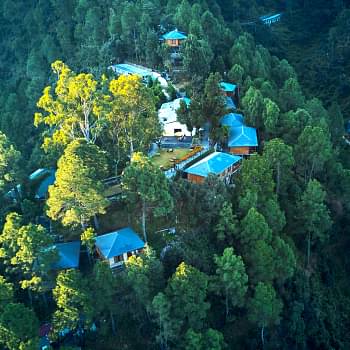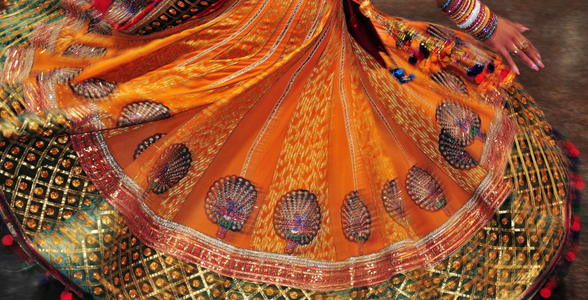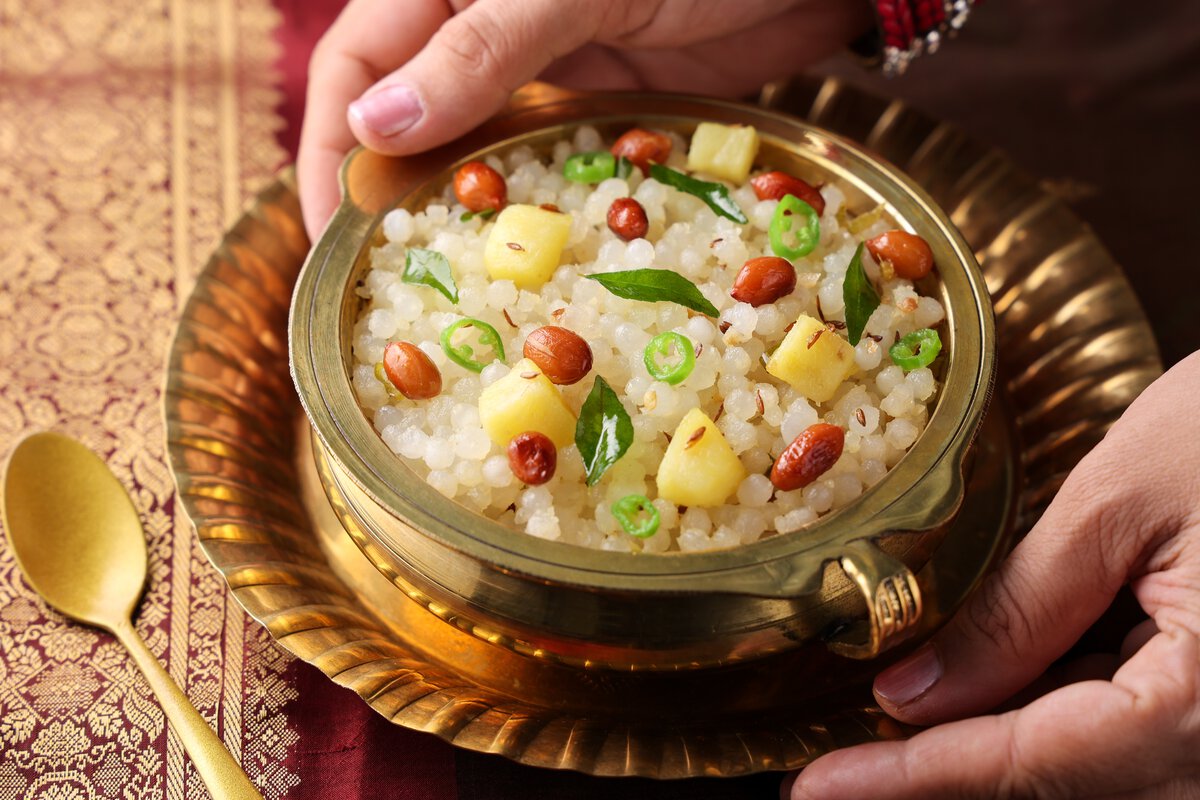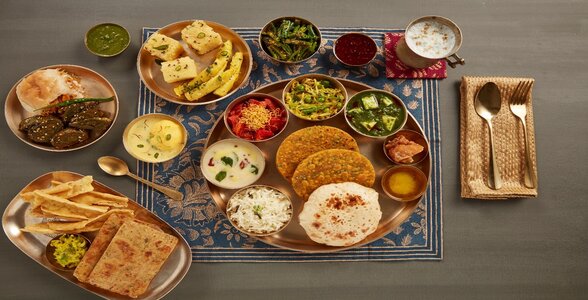October 01, 2021
A Guide to Gujarat’s Festive Gala – Navratri!
CM Content Team


View all
140+
Resorts
October 01, 2021
CM Content Team
Get ready for the most awaited cultural extravaganza of the year – Navratri 2024! This guide is your gateway to understanding and immersing yourself in the magic of this Gujarat Festival-Navratri. As the beats of Garba and the clatter of Dandiya sticks fill the air, Navratri transforms into a grand Gujarat festival of dance, devotion, and dazzling colours. Whether you're a Navratri enthusiast or planning to partake in this cultural phenomenon for the first time, this guide will provide you with insights, tips, and a deeper understanding of festivities of Gujarat during Navratri .
During the auspicious Navratri the Gujarat festival spans nine days, each day is associated with a specific colour that holds deep significance. These symbolize various aspects of the festival, and devotees often dress in the designated colour of the day to pay homage to the Goddess and seek her blessings. The nine colours of Navratri represent different qualities and energies.
Here's a brief overview of the nine colours of Navratri 2024:

During the auspicious festival of Navratri, which spans nine days, each day is associated with a specific colour that holds deep significance. These symbolize various aspects of the festival, and devotees often dress in the designated colour of the day to pay homage to the Goddess and seek her blessings. The nine colours of Navratri represent different qualities and energies.
Here's a brief overview of the nine colours of Navratri 2023:
|
Navratri Day |
Date |
Colour of the Day |
Significance of the Colour |
|
Day 1 |
October 03, 2024, Thursday |
Yellow |
Unparallel optimism and joy |
|
Day 2 |
October 04, 2024, Friday |
Green |
Growth, fertility, peace and serenity |
|
Day 3 |
October 05, 2024, Saturday |
Grey |
Balanced emotions |
|
Day 4 |
October 06, 2024, Sunday |
Orange |
Warmth, exuberance and positive energy |
|
Day 5 |
October 07, 2024, Monday |
White |
Purity and innocence |
|
Day 6 |
October 08, 2024, Tuesday |
Red |
Love, vigour and vitality |
|
Day 7 |
October 09, 2024, Wednesday |
Royal Blue |
Richness, tranquillity and elegance |
|
Day 8 |
October 10, 2024, Thursday |
Pink |
Love, affection and harmony |
|
Day 9 |
October 11, 2024, Friday |
Purple |
Luxury, grandeur, opulence, and richness |
Also Read: How Is Navratri Celebrated in Different Parts of India?
Did you know that the mythology behind Navratri is deeply intertwined with the festival's origins, especially in the context of Gujarat festivities?
The first one has to do with the battle fought between Goddess Durga and Demon Mahishasura. It is believed that Lord Shiva, upon the plea of the other Gods, called upon Goddess Durga for aid. She took on 9 different avatars – the Nava Durga –Shailaputri, Brahmacharini, Chandraghanta, Kushmanda, Skandamata, Katyayani, Kaalratri, Mahagauri, Siddhidatri. For a period of 9 days and nights, she duelled with the demon, until finally, good triumphed over evil. Each day of Navratri is dedicated to one of these incarnations, making it a significant festival in Gujarat.
Another story linked to this vibrant festival of Gujarat involves Goddess Sati, who married Lord Shiva against the wishes of her father, King Daksha Prajapati. In an act of vengeance, King Daksha organised a huge Yagna (ritual) and invited all the Gods, except his new son-in-law. Sati decided to attend the Yagna, despite Lord Shiva's attempt to persuade her otherwise. Daksha ignored his daughter's presence and publicly degraded Lord Shiva. Unable to bear her father’s insults, she committed suicide by jumping into the fire. However, she was reborn again, won Lord Shiva as her groom, and peace was eventually restored into the kingdom. Deities believe that she visits her parents’ home every year during Navratri making it a cherished part of the Gujarat festival.

As the sun sets and the stars begin to twinkle, Gujarat transforms into a mesmerizing canvas of lights, colours, and rhythmic beats.
Welcome to Navratri, the nine-night festival that celebrates the divine feminine energy through dance, devotion, and sheer joy. At the heart of the festivities in Gujarat are Garba and Dandiya Raas, traditional dances that captivate hearts and create memories that last a lifetime. Join us as we dive into the exuberant world of Garba and Dandiya Raas, where every step and twirl tells a story of culture, tradition, and community spirit.
The Essence of Garba: Garba, a highlight of Gujarat festivities, is more than just a dance; it's a spiritual journey representing the cyclical nature of life. The term "Garba," derived from the Sanskrit word for womb, symbolizes the cycle from birth to death to rebirth. Performed around a central idol or lamp called Garbha Deep, representing goddess Durga, dancers in vibrant traditional attire move in concentric circles, clapping and singing folk songs. The music blends traditional folk with contemporary beats, featuring dhol drumming, harmonium tunes, and soulful singing, narrating mythological stories and praising the goddess, fostering a sense of community and togetherness.
The Magic of Dandiya Raas: Following the soulful Garba, the night transitions into the energetic and playful Dandiya Raas. This dance, a staple in Gujarat festival traditions, involves the use of decorated wooden sticks called dandiyas. Dancers pair up and strike their dandiyas together in a rhythmic, synchronized manner, creating a lively and festive atmosphere.
Dandiya Raas is characterized by its energetic steps and vibrant movements, where dancers form a circle and pairs move in and out, striking their dandiyas in intricate patterns. The dance is a delightful combination of coordination, rhythm, and enthusiasm, often building up in pace as the night progresses.
The Attire: In Gujarat festivities, traditional attire plays a significant role. For women, the Chaniya Choli—a three-piece outfit consisting of a flared skirt (chaniya), a blouse (choli), and a dupatta—is adorned with intricate mirror work, embroidery, and bright colors that reflect the spirit of Navratri.
Men typically wear Kediyu (a short, flared kurta) paired with dhoti or pyjama, also embellished with embroidery and mirrors, enhancing the overall festive vibe.
Also Read:Durga Temples in India You Must Visit This Durga Pooja

Many devotees observe fasts, during this festival in Gujarat, consuming only specific foods that are permissible during this period. Some popular fasting foods include:
Sabudana Khichdi: A dish made from sago pearls, peanuts, and potatoes, seasoned with mild spices.
Rajgira Rotis: Flatbreads made from amaranth flour, often paired with yogurt or vegetables.
Singhara Halwa: A sweet dish made from water chestnut flour, ghee, and sugar, garnished with nuts.

The non-fasting meals during Navratri in Gujarat festivities are a culinary celebration, showcasing an array of traditional Gujarati dishes. Some of the most popular ones include:
Dhokla: A steamed cake made from fermented rice and chickpea batter, garnished with mustard seeds and green chilies.
Khandvi: Thin, rolled pieces of gram flour cooked with yogurt and tempered with mustard seeds and curry leaves.
Mohanthal: A rich, gram flour fudge flavoured with cardamom and saffron, often garnished with almonds and pistachios.
Thali: Traditional Gujarati thali with dishes like kadhi, undhiyu (mixed vegetable dish), thepla (spiced flatbread), and dal dhokli (lentil stew with wheat flour noodles).
Also Read: Durga Pujo in Kolkata- Important Days, Worships, and the Rituals
Navratri, one of the most celebrated festivals in Gujarat, is a vibrant blend of devotion, dance, and traditions. Each day of this nine-day festival in Gujarat festivities is marked by unique customs, rituals, and daily pujas (prayers) dedicated to the goddess Durga and her nine avatars. Here's a detailed look at the customs, rituals, and daily pujas that define Navratri in Gujarat:
This marks the beginning of Navratri. A kalash (sacred pot) is filled with holy water and placed on a bed of soil, in which barley seeds are sown. The kalash is then adorned with a coconut and mango leaves, symbolizing the goddess.
This ritual invokes the presence of the goddess Durga in the home and is a call for her blessings and protection throughout the Gujarat festival.
Morning and Evening Prayers: As part of Gujarat festivities, devotees perform daily prayers during Navratri, offering flowers, fruits, and sweets to the deity. The puja includes the chanting of Durga Saptashati or other hymns dedicated to the goddess Durga. The ritual of aarti (waving of lamps) is conducted with great devotion, accompanied by traditional songs praising the goddess.
Altar Decoration: A clean and beautifully decorated altar is set up in homes and temples during these Gujarat festival celebrations. The idol or image of the goddess is placed on the altar, adorned with flowers, jewellery, and colourful garments.
|
Day |
Goddess |
Offerings |
Significance |
|
Day 1 |
Shailaputri |
Ghee and Aarti |
Worship of Shailaputri, the daughter of the mountains, symbolizing strength and vigor. |
|
Day 2 |
Brahmacharini |
Sugar and Fruits |
Worship of Brahmacharini, the goddess of penance, representing devotion and calmness. |
|
Day 3 |
Chandraghanta |
Milk and Sweets |
Worship of Chandraghanta, the goddess of peace and prosperity, symbolizing bravery and serenity. |
|
Day 4 |
Kushmanda |
Pumpkin and Flowers |
Worship of Kushmanda, the creator of the universe, symbolizing joy and energy. |
|
Day 5 |
Skandamata |
Bananas and Sweets |
Worship of Skandamata, the mother of Skanda, symbolizing motherhood and salvation. |
|
Day 6 |
Katyayani |
Honey and Flowers |
Worship of Katyayani, the warrior goddess, symbolizing courage and righteousness. |
|
Day 7 |
Kaalratri |
Jaggery and Aarti |
Worship of Kaalratri, the destroyer of darkness, symbolizing protection and power. |
|
Day 8 |
Mahagauri |
Coconut and Sweets |
Worship of Mahagauri, the goddess of purity, symbolizing peace and endurance. |
|
Day 9 |
Siddhidatri |
Sesame Seeds and Fruits |
Worship of Siddhidatri, the goddess who grants all achievements, symbolizing perfection and accomplishment. |
On Day 8 or 9, young girls (pre-puberty) are worshipped as incarnations of the goddess. Their feet are washed, they are adorned with flowers, and given gifts and prasad (blessed food).
This ritual during the Gujarat festival of Navaratri honours the divine feminine and seeks the blessings of the goddess through the purity and innocence of young girls.
Navratri, a key celebration in Gujarat festivities, spans nine nights and begins on the first day of the fortnight in the Hindu month of Ashwin, typically in September or October. The festival concludes with Dussehra or Vijayadashami on the tenth day. According to texts like the Shakta and Vaishnava Puranas, Navratri can occur two or four times a year, with Sharada Navratri in autumn being the most widely celebrated, followed by Vasanta Navratri in spring.
Experience Navratri Away from Home with Club Mahindra Resorts in Gujarat!
If you're looking to celebrate the Gujarat festival of Navratri away from your hometown or experience this vibrant festival for the first time, look no further than Club Mahindra Resorts in Gujarat.
The resorts in Gujarat, including Club Mahindra Gir, Club Mahindra Dwarka, Club Mahindra Netrang, and Club Mahindra Kensville Golf Resort Ahmedabad, provide warm and inviting atmospheres that are perfect for festive gatherings. Their friendly staff and fun-filled activities ensure that you'll have a memorable Navratri experience. Moreover, Club Mahindra Resorts in Gujarat is known for its special Navratri celebrations, including lively Garba and Dandiya Raas activities that allow you to immerse in the festive spirit. To get access to all these resorts, along with 140 + resorts in the country and abroad, get yourself a Club Mahindra membership. Talk to our team to know more about the membership plans and choose the plan that fits your needs.
So, put on your Gujarati festive finest, grab your dandiya sticks, and get ready to groove to the Garba beats!
Mahindra Holidays & Resorts India Ltd. (MHRIL), a part of Leisure and Hospitality sector of the Mahindra Group, offers quality family holidays primarily through vacation ownership memberships and brings to the industry values such as reliability, trust and customer satisfaction. Started in 1996, the company's flagship brand ‘Club Mahindra’, today has over 300,000 members , who can holiday at 140+ resorts in India and abroad.
We use cookies to personalise content and to provide you with an improved user experience.By Continuing to browse this site you consent to the use of cookies.Please visit our cookie policy for further details.

Welcome to ClubMahindra.com In order to provide a personalised experience for you, we use cookies to enable some website functionality. Cookies help us see which articles most interest you; allow you to easily share articles on social media channels; permit us to deliver content personalised to your interests and locations; along with many other site benefits. For more information, please review our Cookie Policy
When you visit any website, it may store or retrieve information on your browser, mostly in the form of cookies. This information might be about you, your preferences or your device and is mostly used to make the site work as you expect it to. The information does not usually directly identify you, but it can give you a more personalized web experience. Because we respect your right to privacy, you can choose not to allow some types of cookies. Click on the different category headings to find out more and change our default settings. However, blocking some types of cookies may impact your experience of the site and the services we are able to offer.
Because we respect your right to privacy, you can choose not to allow some types of cookies and you have the right to withdraw your consent by send a mail to email id [email protected]
These cookies are essential in order to enable you to move around the site and use its features, such as accessing secure areas of the site. Without these cookies, services you have asked for cannot be provided.
These cookies allow us to employ data analytics so we can measure and improve the performance of our site and provide more relevant content to you. These cookies don't collect information that identifies a visitor down to an individual level that is available to us. These cookies are not passing personally identifiable information to any external third party other than in limited cases when we engage a service provider to act on our behalf but who is then unable to use the data for their own purposes.
Performance cookies are generally third-party cookies from vendors we work with or who work on our behalf that collect information about your visit and use of the Club Mahindra website, for instance which pages you visit the most often, and if you get error messages from web pages. These cookies don't collect information that identifies a visitor. All information these cookies collect is anonymous and is only used to improve your overall experience on how the website works. Third party vendors may have access to this data and may use it to improve their overall services and offerings.
Functionality cookies allow a site to remember choices you make (such as your user name, language or the region you are in) and provide more enhanced, personal features. These cookies cannot track your browsing activity on other websites. They don't gather any information about you that could be used for advertising or remembering where you've been on the Internet outside our site.
Third-party advertising and social media cookies are used to (1) deliver advertisements more relevant to you and your interests; (2) limit the number of times you see an advertisement; (3) help measure the effectiveness of the advertising campaign; and (4) understand people's behaviour after they view an advertisement. They are usually placed on behalf of advertising networks with the site operator's permission. They remember that you have visited a site and quite often they will be linked to site functionality provided by the other organization. This may impact the content and messages you see on other websites you visit. If you do not allow these cookies you may not be able to use or see certain these sharing tools content on our website.